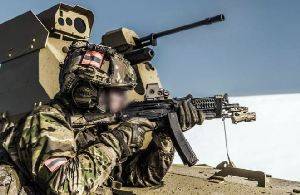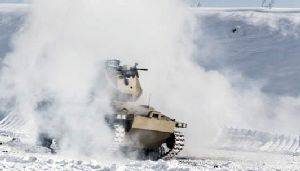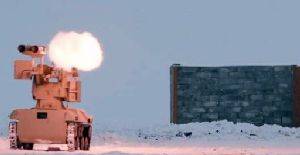Articles >>
In Russia conducted winter tests of Combat UGV
Category: Robots

On March 6, 2018, the Kalashnikov Concern published information on recent tests of equipment and weapons, the purpose of which was to test the operation of all systems in low-temperature conditions. The company published a brief description of this event, as well as shared photos and videos. The press service of the concern explained what exactly specialists were doing during the recent tests and what tasks they were solving. Specialists of the concern "Kalashnikov" in one of the polygons near Moscow tested several products intended for the army and law enforcement agencies, such as:
|

CUGV have demonstrated that it can move through the snow and work in low temperatures conditions. They also demonstrated the possibility of interacting with human in the common combat missions. While assaulting on a building with a conventional adversary, one of these vehicles used weapons, after that another system used a machine gun. |

Soratnik
The project of the Soratnik CUGV was developed several years ago, and the first demonstration of the prototype took place on the "Army-2016" military-technical forum. The project provides for the creation of a self-propelled medium sized tracked platform, suitable for mounting a variety of weapons or special systems. The project was developed by the Kalashnikov Concern in accordance with the requirements of the Ministry of Defense of Russia. The base of the Soratnik is a multi-purpose tracked chassis. This vehicle equipped with light armor and has an internal combustion engine with a mechanical transmission. The tracked chassis is used with five small-diameter road wheels on each side. Wheels have an independent torsion bars, some of them also use shock absorbers. Soratnik has several video cameras. In the latest versions of the project, large armored components were replaced by units of reduced dimensions. The signal from the video cameras is transmitted by radio to the operator's console. Back for the two-way channel commands are received for the powerpack and transmission, as well as for special equipment. |

On the roof of the CUGV body there is a place fot integration another equipment. First of all, Soratnik is considered as a carrier of light infantry weapons, suitable for the destruction of manpower, unarmored equipment and unprotected buildings. This time the CUGV has a new turret. A special feature of the new weapon station was the use of an additional shield. In front of the main body of the weapon station, designed for mounting optical-electronic means, an armored shield of complex shape is installed, providing protection from attacks from the front and from the side. The machine gun and the sensor unit, are located above the upper cut of the frontal sheet. On the left of the weapon station is a protected unit with optoelectronic equipment. At the disposal of the operator there is a video camera, a thermal imager and a laser rangefinder, interacting with the fire control system. For testing, Soratnik CUGV received a set of weapons, which allows to solve different combat tasks. On the weapon station, a PKTM machine gun and an automatic grenade launcher AG-17A were mounted. With the help of such weapons, the system is able to deal with different goals that do not have powerful protection. Soratnik, depending on the configuration, can have a combat weight of up to 7 tons. The powerpack allows it to has on the highway maximum speed up to 40 km/h. The road range of the vehicle is 10 km. In this case, the terrain on which the complex operates should not interfere with the transmission of radio signals to the operator's console and to the CUGV. In time of any missions Soratnik can work independently or together with humans. So, during the winter tests the CUGV supported the assaulting of the building. It protected the fighters by armored hull, and also used weapon. Thus, it can perform the functions of a scout, an assault vehicle or an escort and support for infantry. |

Nahlebnik
The Nahlebnik robotic complex is another variant of a CUGV capable of solving a variety of tasks in different conditions. The main difference of this vehicle from the Soratnik is the reduced size and weight. Due to this, the new complex can be used as a supplement to a larger vehicle. The combined use of two CUGVs with different characteristics may give certain advantages. The Nahlebnik project started several years ago. In February 2017, the Kalashnikov Concern for the first time demonstrated a prototype of this CUGV. The prototype was demonstrated along with the weapon station with a multi-barreled machine gun. Subsequently, the project was finalized, and now experienced automated systems can carry other weapons. In May 2017, the management of the Kalashnikov Concern turned out that this project was designed as an experiment and was intended for testing various technical solutions. The main purpose of the work was to study new variants of layout of small-sized equipment with the most dense placement of units. The experiment ended with luck and allowed to collect the necessary data. |

The basis of Nahlebnik CUGV, as in the case of Soratnik, is a multi-purpose tracked platform. Control is carried out with the help of an operator's console with the transmission of video signals and commands on a two-way protected radio channel. Nahlebnik is equipped with an internal combustion engine, and also differs from the Soratnik design of the undercarriage. This time there are only four road wheels on each side of the hull. Suspension - independent, based on the balances and springs. In the undercarriage, the front idler, standardized with the road wheels, and the rear drive sprocket are provided. Initially, the Nahlebnik CUGV was demonstrated with a remotely controlled weapon station equipped with a GSH-7,62 four-barrel machine gun. On the left side of the RWS was an optoelectronic unit, on the right - a amunition box. During the recent tests, the CUGV had an altered configuration. On the roof of the RWS, there are 4 ATGMs. Unlike the larger Soratnik, the relatively compact Nahlebnik, as follows from the published materials, worked on the ground only on its own. The joint work of the CUGV and humans was not worked out. Soratnik and Nahlebnik CUGVs, developed by the Kalashnikov Concern, were presented to the general public in 2016 and 2017. Over the past time, in parallel with the improvement of projects, various tests were carried out. Works on new models of technology are continuing, and, possibly, in the future, CUGV s will reach the point of acceptance for operation in the army. It is curious that the company-developer plans to create other models of combat robotic systems. Last spring it was announced that on the basis of existing vehicle, a CUGV project with a mass of about 20 tons is being created. The current successes of such a project of special interest have not yet been announced. Perhaps the first information about its real results will appear in the very near future. CUGV s with weapon or another equipment are not just an actual trend in the field of military equipment. Such systems have a number of characteristic advantages and are of great interest to the armed forces. To date, the Russian defense industry has created a number of samples of this kind, and the development process continues. |
Problems of Russian land military vehicles with diesel engines
24.12.2020
Uran-9 Combat Robots began to enter into service in the Armed Forces of Russia
25.01.2019
Three-axis amphibious armored truck was created in Belarus
20.03.2018
Soratnik UCGV was tested in Syria
21.01.2018
MBDU Kalashnikov (Remote controlled weapon station)
BAS-01G Soratnik (Robot, Unmanned Vehicle)
Nahlebnik (Robot, Unmanned Vehicle)
Discuss
